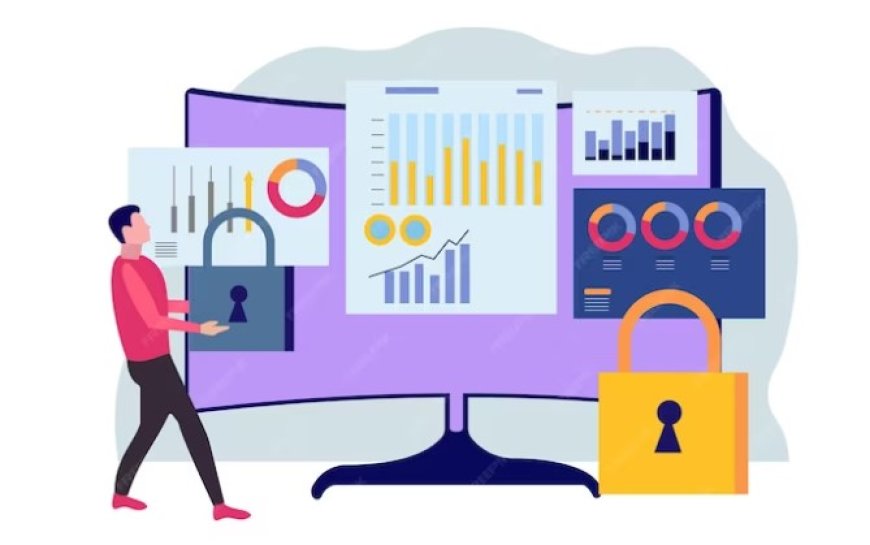The Role of Data Analytics in Cybersecurity
Explore the pivotal role of data analytics in bolstering cybersecurity. Learn how analytics tools enhance threat detection and protect against cyber threats.

Cybersecurity is a field that keeps evolving. It is always changing, especially with advancements in technology. Nowadays, organizations are dealing with more cyberattacks than ever before, and these attacks are getting more sophisticated. We live in a time dominated by digital technology, and the challenges are high. That's where data analytics comes in. It's becoming super important in the world of cybersecurity.
Cyber Threats
The online threats have become more advanced and widespread. Cybercriminals are using tricky methods like ransomware, phishing, and zero-day exploits to break into systems and get hold of important information. The usual security methods we used before aren't enough to stop these new kinds of threats. Now, organizations need a smarter and more proactive way to find, deal with, and stop these cyberattacks.
The Limitations of Traditional Cybersecurity Measures
Most of the time, the usual ways we try to keep our digital systems safe use set rules and patterns to find known dangers. These methods work okay, but they're not great when it comes to new and smart attacks. Plus, there's so much data coming in from our systems nowadays that it's just too much for people to keep an eye on. This means that sometimes, the people in charge of security might miss the small signs that something bad is happening, and by the time they notice, a lot of damage could already be done.
How does using data analytics make cybersecurity better?
Detecting and Preventing Threats
One of the primary ways data analytics enhanced cybersecurity is through improved threat detection and prevention. By employing advanced analytics, organizations can identify unusual patterns and behaviors within vast datasets. This approach allows for the establishment of a baseline of normal behavior. Any deviation from this baseline can then be flagged as a potential threat, enabling real-time detection and mitigation of cyber threats.
Behavioral analytics is another facet of threat detection. By analyzing user behavior, data analytics helps uncover abnormal activities that might indicate a compromised account or an insider threat. Creating behavior baselines for users and systems allows security teams to quickly identify and respond to deviations from the norm.
Incident Response and Forensics:
If there's a situation where a cyber attack happens, data analytics plays a crucial role in incident response and forensics. It helps in correlating disparate pieces of information, reconstructing the timeline of events, understanding the attack vectors, and determining the extent of the breach. This capability is vital for organizations seeking to recover from an incident and strengthen their defenses against future threats.
Forensic analysis, powered by data analytics, involves examining log files, network traffic, and system behavior to trace the origin of an attack. It enables cybersecurity professionals to gather evidence, understand the tactics employed by the attackers, and attribute the incident to specific threat actors.
Predictive Analysis for Proactive Security:
Data analytics contributes significantly to proactive security measures through predictive analysis. By integrating threat intelligence feeds, organizations can stay ahead of emerging threats. Predictive analytics, based on historical data and identified patterns, enables anticipation of potential future attacks. This forward-looking approach empowers organizations to implement proactive security measures and safeguard against threats before they materialize.
Additionally, data analytics facilitates real-time vulnerability assessment by analyzing system configurations, patch levels, and network traffic. This proactive approach allows organizations to identify and address potential weaknesses before they can be exploited by malicious actors.
User and Entity Behavior Analytics (UEBA):
-
Against Insider Threats: Data analytics serves as a watchful eye on user activity, identifying anomalous behavior that might indicate an insider threat. Whether intentional or unintentional, data analytics helps organizations detect and prevent internal security breaches.
-
Continuous Monitoring for Timely Action: Instead of periodic check-ins, data analytics provides continuous monitoring of user and entity behavior. It's like having a round-the-clock security guard for digital spaces, ensuring that any suspicious activity is promptly addressed. This reduces the dwell time of potential threats within the network.
Challenges in Implementation:
While the benefits of integrating data analytics into cybersecurity are evident, there are challenges in its implementation. Organizations may face issues related to the volume and diversity of data, the need for skilled personnel, and ensuring the ethical use of data. Overcoming these challenges requires a thoughtful approach to technology adoption, skill development, and establishing ethical guidelines for data analytics in cybersecurity.
While the idea of incorporating data analytics into cybersecurity holds great promise, it comes with its fair share of challenges along the way.
-
Data Overload: The sheer volume of data generated in today's digital landscape can be overwhelming. Sorting through massive datasets to identify relevant information for cybersecurity purposes becomes a daunting task. Implementing effective data management strategies is crucial. This involves prioritizing data, focusing on what is most relevant to cybersecurity goals, and leveraging technologies that can streamline data processing.
-
Data Diversity: Cybersecurity data comes in various forms: logs, network traffic, user behavior data, and more. Integrating and analyzing diverse data types can be complex, especially when each type requires a unique approach.Employing versatile data analytics tools that can handle diverse data types is essential. This ensures that organizations can extract meaningful insights from different sources, creating a comprehensive view of their cybersecurity landscape.
-
Skilled Personnel Shortage: The demand for professionals with expertise in both cybersecurity and data analytics often exceeds the available talent pool. Finding individuals with the right skill set to implement and manage these technologies is a significant challenge. Investing in training programs and fostering a culture of continuous learning within the organization can address this shortage. Collaboration with educational institutions and cybersecurity training providers can also be valuable in building a skilled workforce.
-
Technology Adoption Challenges: Introducing new technologies, especially those as sophisticated as data analytics tools, can face resistance within an organization. This may be due to concerns about disruptions, compatibility issues, or a lack of understanding about the benefits. A phased and well-communicated approach to technology adoption is essential. Organizations should provide comprehensive training to staff, clearly articulate the benefits, and address concerns collaboratively. Demonstrating success through pilot projects can also help overcome resistance.
-
Integration with Existing Systems: Many organizations already have established cybersecurity systems in place. Integrating data analytics seamlessly with existing tools and processes can be a complex task. Prioritizing interoperability during the selection of data analytics solutions is crucial. This ensures a smoother integration process, minimizing disruptions to ongoing cybersecurity operations. Regular evaluations and adjustments may also be necessary.
-
Ethical Use of Data: Balancing the need for effective cybersecurity with ethical considerations in data usage can be challenging. Privacy concerns and potential misuse of sensitive information pose significant ethical dilemmas. Establishing clear ethical guidelines and protocols for data usage is imperative. Organizations should prioritize transparency in their data analytics practices, obtain informed consent when necessary, and adhere to relevant data protection regulations.
While the challenges of implementing data analytics in cybersecurity are real, these challenges can be overcome. A thoughtful and strategic approach can pave the way for successful integration, making sure that companies fully use the power of data analytics to strengthen their cybersecurity efforts.By addressing issues related to data management, talent acquisition, technology adoption, and ethical considerations, companies can overcome these challenges and build a strong cybersecurity system by using the valuable insights gained from data analytics. As technology keeps advancing, organizations must tackle these challenges head-on if they want to stay ahead of the constantly changing threat landscape.
The role of data analytics in cybersecurity is comparable to having an intelligent, proactive ally in the ongoing battle against cyber threats. It not only detects and responds to incidents but also plays a pivotal role in predicting and preventing future attacks. As technology advances, the digital realm becomes more complex, and the reliance on data analytics becomes increasingly crucial for organizations aiming to safeguard their digital assets and maintain a resilient cybersecurity posture.


























































